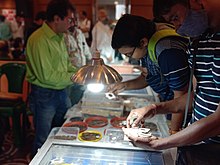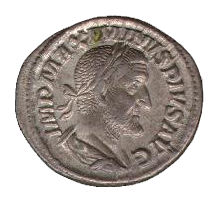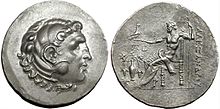Numismatics
| Part of a series on |
| Numismatics the study of currency |
|---|
 |
Numismatics is the study or collection of currency, including coins, tokens, paper money, medals and related objects.
Specialists, known as

The earliest forms of money used by people are categorised by collectors as "odd and curious",
Etymology
First attested in English in 1829, the word numismatics comes from the adjective numismatic, meaning 'of coins'. It was borrowed in 1792 from
History of money
Throughout its history, money itself has been made to be a
. Many complementary currencies use time as a unit of measure, using mutual credit accounting that keeps the balance of money intact.Modern money (along with most ancient money) is essentially a token – an abstraction. Paper currency is perhaps the most common type of contemporary physical money. However, goods such as gold or silver retain many of the essential properties of money, such as price fluctuation and limited supply, although these goods are not controlled by one single authority.
History of numismatics

Petrarch, who wrote in a letter that he was often approached by vine diggers with old coins asking him to buy or to identify the ruler, is credited as the first Renaissance collector. Petrarch presented a collection of Roman coins to Emperor Charles IV in 1355.
The first book on coins was De Asse et Partibus (1514) by
Professional societies organised in the 19th century. The Royal Numismatic Society was founded in 1836 and immediately began publishing the journal that became the Numismatic Chronicle. The American Numismatic Society was founded in 1858 and began publishing the American Journal of Numismatics in 1866.
In 1931 the British Academy launched the Sylloge Nummorum Graecorum publishing collections of Ancient Greek coinage. The first volume of Sylloge of Coins of the British Isles was published in 1958.
In the 20th century, coins gained recognition as archaeological objects, and scholars such as Guido Bruck of the Kunsthistorisches Museum in Vienna realized their value in providing a temporal context and the difficulty that curators faced when identifying worn coins using classical literature. After World War II in Germany, a project, Fundmünzen der Antike (Coin finds of the Classical Period) was launched to register every coin found within Germany. This idea found successors in many countries.
In the United States, the US Mint established a coin cabinet in 1838 when chief coiner Adam Eckfeldt donated his personal collection.[12] William E. Du Bois' Pledges of History... (1846) describes the cabinet.
C. Wyllys Betts' American colonial history illustrated by contemporary medals (1894) set the groundwork for the study of American historical medals.
Helen Wang's "A short history of Chinese numismatics in European languages" (2012–2013) gives an outline history of Western countries' understanding of Chinese numismatics.[13] Lyce Jankowski's Les amis des monnaies is an in-depth study of Chinese numismatics in China in the 19th century.[14]
Modern numismatics

Modern numismatics is the study of the coins of the mid-17th century onward, the period of machine-struck coins.[15] Their study serves more the need of collectors than historians, and it is more often successfully pursued by amateur aficionados than by professional scholars. The focus of modern numismatics frequently lies in the research of production and use of money in historical contexts using mint or other records in order to determine the relative rarity of the coins they study. Varieties, mint-made errors, the results of progressive die wear, mintage figures, and even the sociopolitical context of coin mintings are also matters of interest.
Subfields
Notaphily is the study of paper money or banknotes. It is believed that people have been collecting paper money for as long as it has been in use. However, people only started collecting paper money systematically in Germany in the 1920s, particularly the Serienscheine (Series notes) Notgeld. The turning point occurred in the 1970s when notaphily was established as a separate area by collectors. At the same time, some developed countries such as the United States, Germany, and France began publishing their respective national catalogs of paper money, which represented major points of reference literature.

Scripophily is the study and collection of companies' shares and bonds certificates. It is an area of collecting due to both the inherent beauty of some historical documents as well as the interesting historical context of each document. Some stock certificates are excellent examples of engraving. Occasionally, an old stock document will be found that still has value as stock in a successor company.
See also
Further reading
- Krmnicek Stefan and Hadrien Rambach. (2023). The Numismatic World in the Long Nineteenth Century. New York: Routledge Taylor & Francis Group.
- Pritsak, O. (1998). The Origins of the Old Rus’ Weights and Monetary Systems: Two Studies in Western Eurasian Metrology and Numismatics in the Seventh to Eleventh Centuries (Harvard Series In Ukrainian Studies). Cambridge: Harvard Ukrainian Research Institute.[17][18]
References
- ^ Maurer, B. "Primitive and Nonmetallic Money". In Yago, K.; Battilosi, S.; Cassis., Y. (eds.). Handbook of the History of Money and Currency. Springer. p. 87-104.
- S2CID 254976793.
- ISBN 978-0-7083-1351-0. Archivedfrom the original on 2006-07-14. Retrieved 2006-08-09.
- ^ Harper, Douglas. "numismatics". Online Etymology Dictionary.
- Perseus Project.
- Perseus Project.
- ^ νομίζειν in Liddell and Scott.
- ^ νόμος in Liddell and Scott.
- ^ νέμειν in Liddell and Scott.
- ^ Suetonius, Augustus 75 on-line text Archived 2022-07-31 at the Wayback Machine
- ^ Brigham Young University library web page Archived 2008-07-25 at the Wayback Machine
- ISBN 978-0-8247-2037-7.
- ^ Helen Wang, "A short history of Chinese numismatics in European languages", in Early China vols 35-36 (2012–2013), pp. 395-429,
- ISBN 978-2-37701-030-1.
- ^ "Collectibles". Maritime International. Archived from the original on September 14, 2013. Retrieved June 13, 2013.
- ISBN 978-0951691007
- JSTOR 2679589.
- JSTOR 2697226.
External links
 The dictionary definition of numismatics at Wiktionary
The dictionary definition of numismatics at Wiktionary Media related to Numismatics at Wikimedia Commons
Media related to Numismatics at Wikimedia Commons
